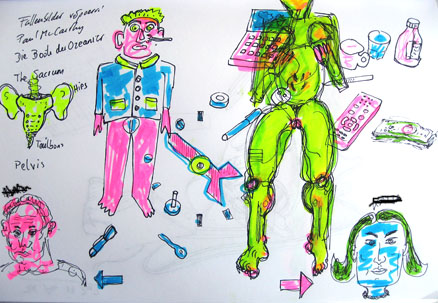
mind content monday august 6 2007 11 pm berlin germany
|
the human matrix, or |
When word, object and mental image are mixed up, confusion arises.
Patanjali - Yoga Sutras (III,17)
You need to rub yourself with words and works.
Put the words to the test of your experience. Do not be carried away by anyone else's words. Rub yourself with each word through work and practice. Rubbing means to experience. Go with it! Find out! You develop original intelligence by rubbing the thought with the experience, and that originality is meditation.
B.K.S. Iyengar
The soul is calm.
The people are lazy.
The individual is stupid.
Boris Groys
overview of problems, questions
(1) I don't know. I don't understand.
(2) Where and why do things go wrong.
limitations
(1) this is a purely logical view on things.
(-) it is not practical.
(-) it is not scientific.
(-) it is not prosaic.
(-) it is not religious.
(-) it is not fictive.
work in progress ... preliminary ... incomplete

mind content monday august 6 2007 11 pm berlin germany
discussion of problems
(1.1) Attention naturally directs to what is loud, big, beautiful,
elegant, sexy, ugly, horrible, informative, changing,
NEW, etcetera.
(3.1) Western science and culture strongly emphasise the attention to
the outer world with visible, tremendous results in culture and science.
(3.2) War, hunger, mass destruction of people, animals and nature, individual
sufferings are justified with reference to the cultural and scientific
progress.
(3.3) Addressing these disasters with western science (looking out) is
doomed to fail. You have to have peace in yourself before you can
bring it to the people. You have to help yourself before you can
help others.
(3.4) Often, not always, at the end of a personal career happens an individual
disaster, catastrophe in form of a depression, desease or suicide. If
not happening by itself, the discerning fellowmen will do their best to make that
happen, as done with Sokrates and Jesus and many more.
From an outside perspective culture and science may look like reckless,
insensitive, hungry beasts. Are the individual oblations a must for
cultural, scientific development?
(3.5) There are strong indications that beeing caught in maya, ignorance is
equivalent to being crazy, mad, sick.
(3.6) Eastern science and culture emphasise the attention to the inner atmospheres
(body, emotion, thought, intelligence, bliss) with promised end of
individual suffering and peaceful interbeing (I borrow this term from
Thich Nhat Hanh, interbeing: nothing and no one
exists on its own, everything which exits relies on many others).
(4.1) The mind is the showroom of the universe. It's our very
personal showroom.
(4.2) Meditation works like an art gallery. Before a new show every
room is cleaned and emptied. If the rooms were not cleaned and emptied
before an exhibition it would not be art but reality show.
(4.3) The artists of that gallery are:
(1) imagination,
(2) memory,
(3) light-,
(4) sound-,
(5) odour-,
(6) taste-,
(7) body-perception,
(8) emotion,
(9) words and thoughts.
Then you have the consumers, which are
(a) the private collector (ego),
(b) the art critic, watcher (intelligence), and
(c) the public museum (conscience, soul).
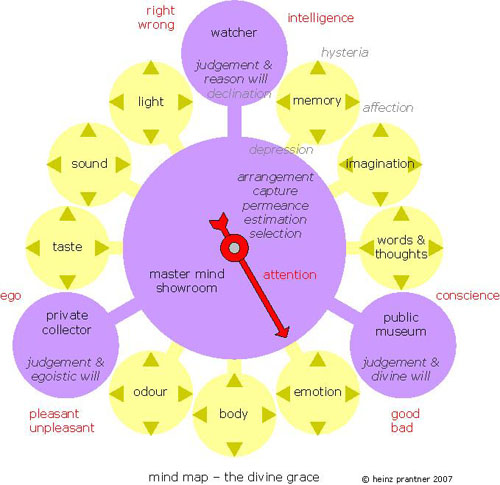
MIND
Everything before entering our mind has to go through perception.
The mind is the showroom of the universe.
The universe experiences itself through mind.
The mind, our minds, every mind is perfect. There is no mind which
is better or worse than other minds. Each and every mind is perfect,
wonderful.
If there is a problem, mind will find a solution. If, let's say,
the memory is not working so well, mind will ask imagination and
phantasy to jump in. You may call this person a liar but it is the
perfect mind which always finds a way out.
The mind does not make mistakes. It acts upon the contents coming
from the various perceptions and draws conclusions based on egoistic
will to get pleasure, reason will to do it right and divine will to
do it good.
The various perceptions may have some afflictions and aberrations so
that the content of mind may not be exactly reflecting that what is
actually out there. The inputs from the world may be subject to
hysteria, depression, affection or declination so that the content
of mind will be distorted, contorted, baroque. Judgenment and action
will be based on the wrong perception and the resulting behaviour
may look strange.
The attention to the various inputs may also not be balanced so that
we overfocus one and ignore the other. One may focus on gesture and
sound someone else may focus on words and thoughts so the content of
mind will be fragmented, incomplete and the perception on one and
the same thing may be different and contradictionary in various minds.
A dispute can easily start from this.
Last but not least the judgement may be based on egoistic will,
reason will and divine will. If any is left out the reflection
will be incomplete and unwise.
EGO
Ego, by nature, is a collector of pleasant impressions. Like any
collector it always wants more.
The second nature of ego is the love for role games playing. The
thought 'I am' is a ego construct. It's a fake. There is no reality
referring to that thought. Ego loves that. I am a policeman or
I am a pilot or I am a captain.
We have several roles which we carry with us and we change between
them all day - I, sportsman, family man, boss, friend, enemy, loser,
driver, drinker, lover, genius, etc.
Each wound we carry with us refers to one role. When we are hurt we
have to check to which role this refers to. If we let go the role
the sorrow goes away together with the role.
The roles and rituals are helpful and needed for cultural
organization and interaction. But as soon as we identify ourselfes
with these roles we are in trouble. Then we are at war with
ourselves and others.
The praised nirvana must be the absence of roles.
Ego roles cannot survive without confirmation. Ego roles need
confirmation by others to exist.
How can I prove that the thought 'I am' is a fake? I think I cannot.
But consider that there is no one single role which does not come
together with the need for confirmation by others. Ego, knowing
the assumed role is a fake, goes out and asks for proof. If it would
be confident there would not be a need for proof. For each
role a repeated stream of acknowledgements is needed like the
nicotine for a smoker. As soon as one confirmation comes in, the
pain from deprivation starts from the beginning until the next
confirmation. Allen Carr explains that wonderfully in how to quit smoking.
What we take as pleasure is the short interruption
of the pain from deprivation by confirmation. We are all multi
complex drug addicts. Drug supply, i.e. ego role confirmation,
is requested on multiple channels in parallel. We look at every
human beeing as a potential drug dealer, drug supplier for us
addicts. The only problem is that everyone wants to be addict but
no one wants to be dealer. When we do not get our rate we get angry.
The strong desire for confirmation I take as the proof that the
ego roles stay on loose ground. The fact that there is
no role without the need for confirmation I take as proof that the
thought 'I am something' or 'I am someone' is void. The thought
'I am' is the prototype of the thought 'I am someone'. 'I am' is a
fake. Is it a fake or is it the biggest miracle on earth?
RELIGION
read from top to down, left to right, then
read from left to right, top to down.
| god | mahat | history | memory | |
| soul | purusa | museum | conscience | |
| holy spirit | buddhi | art critic | intelligence | |
| jesus | ahamkara | art collector | ego | |
| church | manas | galery | mind | |
| priest | guru | galerist | culture | |
| christ | yogi | artist | human being | |
| faith | citta vrttis | art | sensory impressions | |
| salvation | samadhi | black square from malewitsch | death |
INTELLIGENCE
Intelligence is to know what to do.
To do is to change.
FORM
Form is any content of mind, e.g. the thought "I am".
Say a chair is the content of mind: the outside object "chair" is the potential of my inside form "chair". We all have a very good understanding how to deal with chairs. And we have no problem to separate the object chair from the perception of the the chair. The relation of form and potential seem to be more difficult in "I am". Here we take it as a given that the object and the perception is one and the same. The one who thinks "I am" is "I". According to sage Patanjali this is a major mistake (Sutra II,6 cited below).
For a buddhist - to see a chair is to be a chair - is "I am" is "I" fully OK.
|
the two directions of attention |
|
|---|---|
| outward directed consciousness | vyutthana-citta |
| inward directed consciousness | samahita-citta |

The two directions of attention.
|
the four states of consciousnes |
|
|---|---|
| VAISHVANARA | waking |
| UMANI AVASTHA | transition state |
| TAIJASA | dream |
| AHLADINI | transition state |
| PRAJNA | deep sleep |
| SAMADHI | transition state |
| TURIYA | |
Source: Mandukya Upanishad
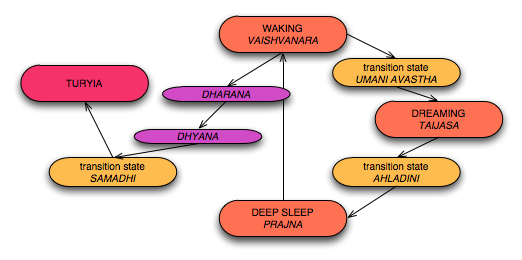
The four states of consciousness Vaishvanara (waking), Taijasa (dream), Prajna (deep sleep) and Turiya, the highest state.
|
the five states of mind ii |
|
|---|---|
| dumb | mudha-citta |
| restless | viksipta-citta |
| agitated | ksipta-citta |
| one pointed | ekagrata-citta |
| elevated | nirodha-citta |
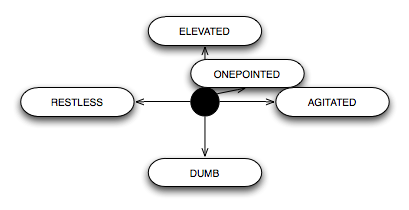
The five mind states.
|
the five states of mind iii |
|
|---|---|
| sleep | nidra-vrtti |
| memory | smrti-vrtti |
| phantasy | vikalpa-vrtti |
| wrong perception | viparyaya-vrtti |
| correct knowledge | pramana-vrtti |
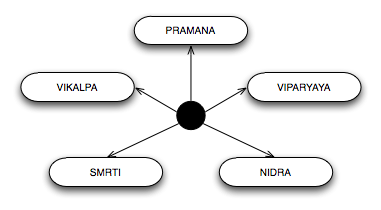
The five mind states.
|
the five inner senses (according to patrick kelly) |
|
|---|---|
| joint position | |
| muscle state | holding, contracting, relaxing, stretching, un-stretching |
| pain | |
| pressure | |
| temperature | |
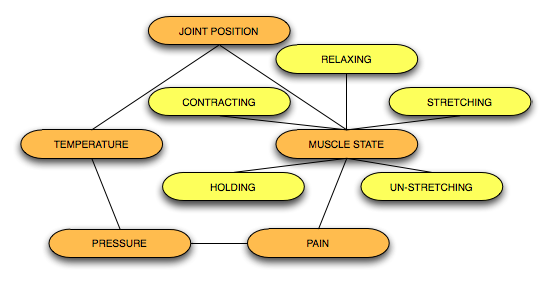
|
the four states of breathing |
|
|---|---|
| puraka | inhalation |
| antara, puraka kumbhaka | inner restraint of breath after inhalation |
| rechaka | exhalation |
| bahya, rechaka kumbhaka | outer restrain of breath after exhalation |
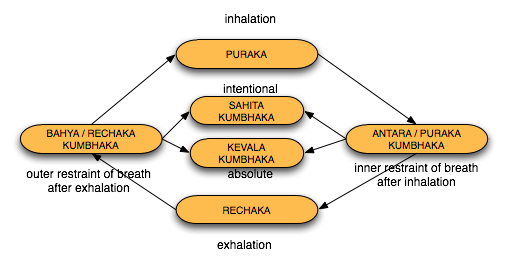
The four breathing states.
|
the five talents - buddhism |
|
|---|---|
| mindfulness | |
| concentration | |
| energy | |
| faith | (compassion, heart) |
| reason | (insight, mind) |
|
the five natural actions |
|
|---|---|
| breathing | |
| eating | |
| perceiving | |
| moving | |
| directing |
|
|
the five steps of action |
|
|---|---|
| stimulus | |
| thought | |
| emotion | |
| reflection | |
action
| |

|
the capabilities of the mind |
|
|---|---|
| mirroring | to reflect what is |
| equating | |
| discriminating | |
| reasoning | to act wisely |
| discerning | to realize reality |
|
the will |
|
|---|---|
| the divine will | |
| the will of nature | linga |
| the will of culture | |
| individual will of intelligent discrimination | buddhi |
| the individual will of ego | ahamkara |
|
the spiritual powers |
|
|---|---|
| bliss, joy, grace, union | |
| intelligence, intuition | |
| reason, distinction, conclusion | |
|
the cultural powers |
|
|---|---|
| roles | (policeman, fireman, pilot, architect, artist, father, mother, husband, lover, gangsta, napoleon, etc... ) |
| money | |
| tools and weapons | |
SUBJECT OBJECT RELATIONS
subject is the topic, the matter, e.g. a cup of coffee.
role is my position, e.g. coffee drinker.
concept is my predefined idea of the topic, e.g. my idea how coffee must taste.
ritual is the procedure I use for this topic, e.g. drink coffee for breakfast and after lunch or drink coffee all day.
object is the actual real thing, e.g. the cup of coffee.
from the relation between the concept (coffee has to be strong) and the
actual object our emotions evolve: this coffee is no good, that coffee is perfect.
|
subject |
role |
concept |
ritual |
object |
remark |
|---|---|---|---|---|---|
| god | no | no | no | yes | the absolute, very objective |
| religion | yes | yes | yes | no | concepts about god |
| religion | yes | yes | yes | yes | concepts about religous life |
| ghosts | yes | yes | yes | no | |
| schizophrenia | yes | yes | yes | no | |
| paranoia | yes | yes | yes | no | |
| self | yes | yes | yes | no | |
| shopping | yes | yes | yes | no | |
| father | yes | yes | yes | yes | |
| mother | yes | yes | yes | yes | |
| teacher | yes | yes | yes | yes | |
| elder | yes | yes | yes | yes | |
| superior | yes | yes | yes | yes | |
| comrade | yes | yes | yes | yes | |
| fellow | yes | yes | yes | yes | |
| friend | yes | yes | yes | yes | |
| lover | yes | yes | yes | yes | |
| younger | yes | yes | yes | yes | |
| subordinate | yes | yes | yes | yes | |
| student | yes | yes | yes | yes | |
| child | yes | yes | yes | yes | |
| entertainment | yes | yes | yes | yes | |
| science | yes | yes | yes | yes | |
| art | yes/no | yes/no | yes/no | yes/no | |
| art | yes | yes | yes | no | Kasimir Malewitsch, black square |
| art | yes | no | no | yes | Marcel Duchamp, ready made |
| art | yes | no | yes | no | Andrei Monastyrsky, empty activities |
| yoga | yes | yes | yes | yes | yama, niyama, asana, pranayama, pratjahara, dharana, dhyana |
| yoga | no | no | no | no | samadhi |
| zen | yes | yes | yes | yes | tea ceremony. the tea drinker, the preparartion, the drinking, the tea |
| zen | no | no | no | no | hishiryo |
see http://de.wikipedia.org/wiki/Hishiryo
OBJECTIVE RELATION WITH GOD
If I take god as absolute and present in everything and relate to everything as my relation to god then there is no role, no concept, no anger, no worry, no doubt, no sorrow, but wonderful interbeing. Since there is no conception of how things and people have to be there is also no emotion evolving out of these relations, this is true mushotoku.
EGO contd.
The nature of ego is role playing. Ego is a role player.
As soon as I apply a role to myself and the according conceptions
of how things and people have to be, I am separated, banished from paradise.
Religion is all about concepts about god and religous life. It is
also about fight with other, different concepts about god.
The nakedness in paradise is the absence of roles, concepts and rituals.
As soon as we take off our roles we enter paradise. here. now.
Yoga, zen and the like are kind of striptease, where we slowly take
off all roles, concepts, rituals, desires, ambitions, aversions, fears.
INDIVIDUALITY
Individuality is made up of the following:
body
setup
perception
reasoning
action, power
No ones individualtiy is fixed. Everything can change.
I try to fit in other peoples conceptions. I am suppressed by
culture. I am a victim of role playing.
I try to make other people to fit into my conceptions. I am
suppressing individuals. I am a victim of role playing.
EMOTIONS
Emotions arise when an object (objective reality) meets a concept.
Each concept belongs, relates to a certain role.
When we analyse the emotion, and denote the related subject, ritual,
desire, concept and role we get the key to ourselves and others.
The sum of all ego-roles - concepts, desires, aversions, fears,
ambitions, rituals - is the key to our understanding.
As with security locks the key becomes more and more complex.
We may use this key to rob others as done in advertisement or to
develop our love towards others. True love comes from understanding.
Our emotions are a wonderful instrument to help our understanding.
It alsmost seems as if we were pushed to understand. If we deny,
ignore, suppress our emotions we become sick.
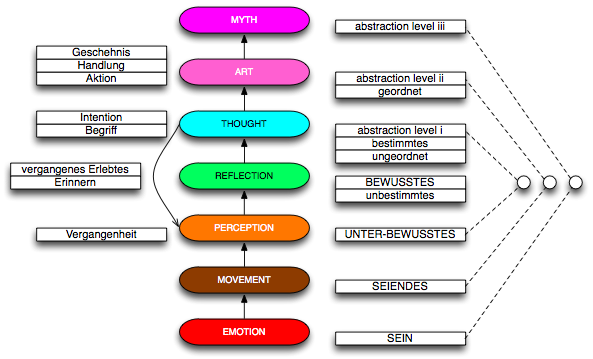
THOUGHTS
Thoughts arise when ego enters a role.
Thoughts arise when ego works on role concepts.
Thoughts arise when role confirmation goes low.
Thoughts arise when an object enters a role.
Every time ego moves or is moved thought waves are kicked off.
Thoughts always relate to a ego role.
Thoughts end when ego does not assume a role.
Thoughts belong to a paricular ego role.
Thoughts are
- ambitious, or
- fearful, or
- longing, or
- declining, or
- conceptual, or
- refer to a ritual.
Impressions reach from the finest, most subtle movements of mind up to pain.
Then there are physical feelings, disturbances, pressures, tensions.
Thoughts are the first alarm.
Emotions are the second alarm. They are less subtle than thoughts.
Pain is the third alarm. Pain is bold.
This whole mechanism is either controlling us or we are the master
of this wonder.
Consider the following sceanrios:
WORDS
Words connect the roles to each other. During our thought stream we
eventually step on words loaded with association. The association
kicks us into a different role and given that into a new concept.
That goes so fast that we don't notice and on we go in a new role-concept
consideration entirely unrelated to what we started with. We may
start with the shopping list and end up in our relation conflicts.
There is nothing wrong with this. But is it right? This role concept
thought roller coaster goes on all day.
Concentration means to stay longer in one role concept without
beeing kicked into the next.
PROBLEMS
To find out whether there is anything wrong with ego roles there is
an easy test I can do: Are my relations to my private and
professional surrounding based on mindfulness, awareness,
understanding, love and joy or are they based on roles games playing
like I am the mother, I am the father, I am the husband, I am the
wife, I am the lover, I am the son, I am the daughter,
I am the friend, I am the boss, I am the employee, I am the author,
I am friedrich nietzsche.
Can it be that the problems I have directly relate to the roles I
play?
Overview of problems categories:
- Ego role has not been confirmed for some while now.
- Ego role ambition has not been met so far for some reason.
- Ego role concepts still have some bugs open, unresolved.
- Ego role desires have not been stilled for some while now.
- Ego role aversions are constantly ignored by reality.
- Ego role fears get more and more substantiation by news every day.
LOGIC
I cannot find any logic in nature. Logic is applied on top of nature and is part of culture. I suspect that logic belongs to ego activities and even find relations between ego role attributes and logical functions as follows:
ego role attribute |
logical function |
|---|---|
role confirmation |
count |
concept |
condition |
ambitions |
comparision |
desires |
inclusion |
aversions |
exclusion |
fears |
negation |
rituals |
operation |
EVOLUTION
Evolution is the diversification of the ego roles. If I list all ego
roles of the society at a given time, I get a snapshot of the
evolution process. The law is that the ego roles become more as we
proceed.
Evolution is the creation and development of ego roles, money and
tools & weapons, i.e. technology.

The development of ego is direct proportional to the development of culture.
The growth of ego is the suppression of humanity.
The growth of culture is the suppression of nature.
ACTIVITY
WORK
There are two choices:
work with motivation
to work with motivation is ego work.
work without motivation
to work without motivation is spiritual work.
work phases:
pushing pulling pressing tucking is ego work to fit into concepts.
allowing, giving space to the alignment to occur is spiritual work.
alignment cannot be enforced like we cannot enforce to fall asleep.
the shoulders have to go back and down is a concept.
concepts may be used to point us to the right direction.
concepts can be abused to suppress our natural intelligence.
to bring, pull, push, press the shoulders back and down is ego concept work.
to let the shoulders go back and down with breath and prana is spiritual work.
doing abhyasa without vairagya makes us tense.
doing vairagya without abhyasa makes us loose.
doing abhyasa and vairagya makes us strong and flexibel.
spiritual work is to give space and time to allow the right thing to happen. the universe is spirituality.
CONTROL
The driving forces to become active:
CONFLICT
NEGATIVITY
Negativity is the confrontation with and opposition to the current situation, moment.
Who said it is our best friend?
CONSERVATISM
In the beginning we learn that the instructions of the teacher given
for the various yoga asanas refer to the intelligence of the body.
The asana is not the sum of the instructions, but the realization of
that intelligence. The instructions just point in the right direction.
And they should not be confused with the intelligence of the body. They
are the intelligene of the teacher. If we just follow blindly the
instructions we never get in touch with the intellience of the body.
But then during our exercise we learn to know that that same body is
cheating all over the places and does not do at all what has been
instructed.
The reason why the body is not doing what it should do is that the
very nature of the body is tamasic, inertia. The body wants to lay
on the couch watching television. The body wants to go with habits
because the habits feel good. The work in the yoga asanas is to move
away from habitual reaction, habitual inertia to intelligent performance.
Doing something different from habit is doing something new and feels
strange, uncomfortable.
Conservatism is to do what we always did, is to avoid change, is to
stay in inertia. Of course there is charm to it.
See also Creativity
(Source: B.K.S.Iyengar through Gabriella Giubilaro, Sep 2007)
CREATIVITY
Creative work is not to invent something new but to repeat the same
and study and refine it.
See also Conservatism
(Source: B.K.S.Iyengar through Gabriella Giubilaro, Sep 2007)
LIMIT
Do not go to your maximum. If you go to your maximum you start to
become stupid. Leave some room for movement. Leave some room to try
out different directions. Leave some room for observation. Leave room
for intelligence. Leave room so you know what you do.
(Source: B.K.S.Iyengar through Gabriella Giubilaro, Sep 2007)
SPIRITUALITY
Spirituality is the work on ego roles. It is to let them go (in peace).
Consider the following confrontation.
east |
west |
|---|---|
looking inside
|
looking inside
|
looking outside
|
looking outside
|
VIRTUE
Virtue is integration.
Iyengar says that if you do what you should not do you lose your integration.
If I think of a scale from less integrated to more integrated I
would not know the criteria how to measure integration. If I
think of what is best and most integrated within itself, how the big
relates to the small, the heavy to the light, the protrusive to
the embracing, active to passive, synthetic to the organic,
integrated with outside others, room, space, urban architecture,
people, sheeps, landscape and universe, then Henry Moore sculptures
come into my mind as the perfect, perfect integration.
And now - and it took me a while - it makes perfect sense that
Dogen Zenji considers the mountains as most virtuous. Of course
they are.
|
the feelings |
|
|---|---|
| body temperature | |
| body pressure | |
| body tension | |
| body disturbance | |
| body surrounding | |
| breath | |
| composition in space | |
| composition in time | |
| constructivism | |
| expressionism | |
| materiality | |
| mood | |
|
the emotions (9 or 8 main emotions according to indian system) |
|
|---|---|
| the angry | |
| the worried | |
| the fearful | |
| the adverse | |
| calm | |
| the joyful | |
| the heroic | |
| the wonderful | |
| the erotic | |
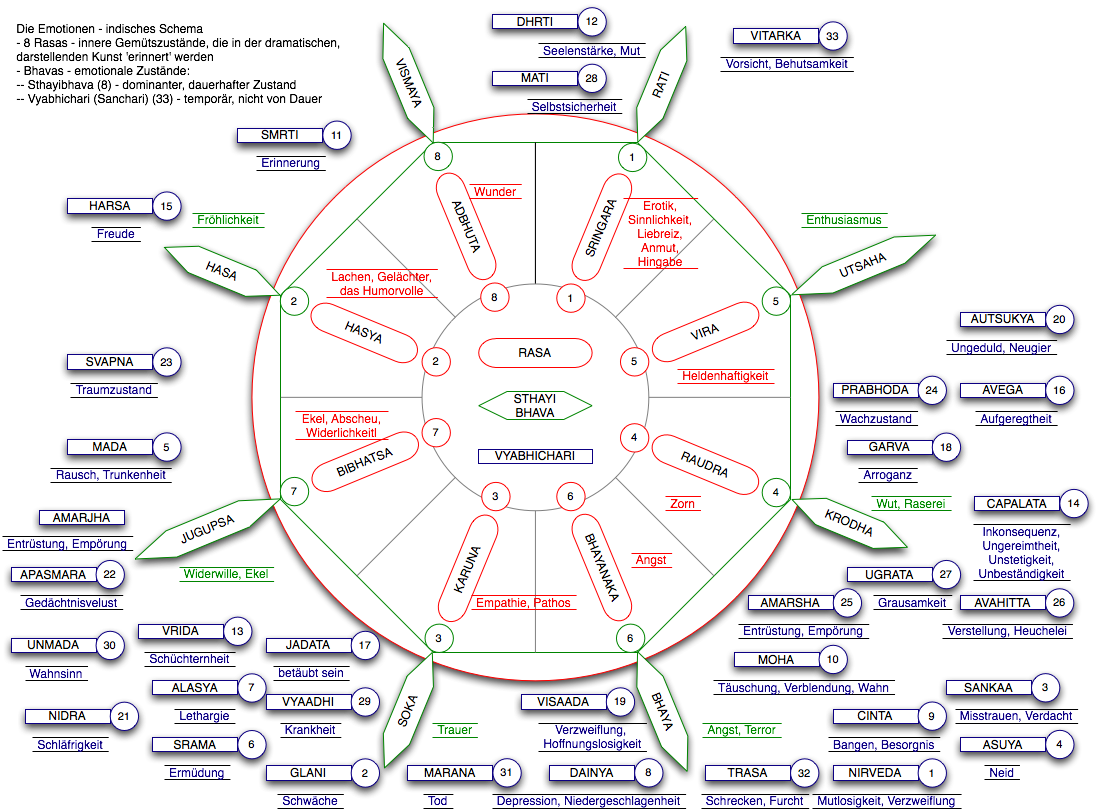
the emotions - indian scheme with rasa, sthayibhava and vyabhichara
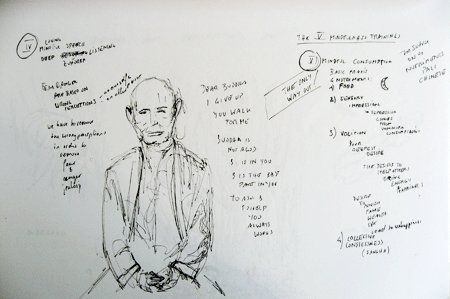
dear buddha I give up. you walk for me. buddha is not a god. buddha is in you. buddha is the best part in you. to ask buddha to help you always works. thich nath hanh

ego afflictions
note:
we have an instrument where form can manifest, our self.
as soon as we take the instrument as something else, then we are caught
in egotism with the afflictions given above. Sutra II,6 drg-darshana-shaktyor ekatmata iva asmita.
egotism (asmita) is the equation of the seer with the instrument of seeing.
perception
perception coordinates
sound perception afflictions
imagination
words and thoughts imagination afflictions
memory
judgement afflictions
will afflictions
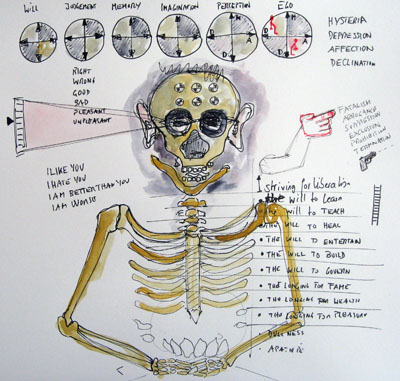
conclusion
end of document